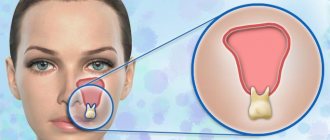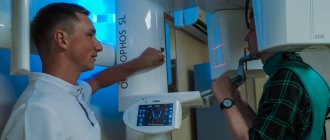In ENT practice, there are cases when a patient comes to an otolaryngologist with complaints of severe nasal congestion and suppuration from the nasal cavity. At the same time, the patient has an elevated body temperature and headaches. But the ENT doctor, having examined the patient, sends him to see a dentist. “Why?”, you will be surprised. Because in this case we are dealing with odontogenic sinusitis.
Sinusitis is a type of sinusitis. The development of sinusitis of odontogenic nature is not associated with colds or acute respiratory viral infections. The main cause of the disease is bad teeth. First, the development of inflammatory tooth disease occurs, after which the inflammatory process from the upper jaw extends beyond the oral cavity and is localized in the maxillary sinus.
Such a state cannot be tolerated. Timely detection of symptoms and diagnosis carried out by a competent ENT doctor will allow timely diagnosis of dental sinusitis and avoid serious complications.
What are the maxillary sinuses
The maxillary sinuses (also called the maxillary sinuses) are special cavities on both sides of the nose that are filled with air. Each cavity is connected to the nasal passage by small openings called anastomoses. The cavities are covered with mucous membrane. The function of mucus is to trap bacteria and harmful particles in it, and then remove them from the body through those same anastomoses. When edema occurs, the excretory opening becomes very narrow, as a result of which mucus, along with harmful particles and bacteria, cannot come out and stagnates. At this time, the patient begins to experience bursting pain in the cheek area - this is how inflammation of the maxillary sinus begins. Treatment of the maxillary sinus should not be neglected, since inaction can provoke serious consequences, including sepsis and meningitis.
Classic sinusitis can be bilateral, when both sinuses are affected. In the odontogenic form, the inflammatory process starts in the sinus on which side the diseased tooth is located.
No need to be afraid of punctures!
Lately there has been a lot of debate about whether to do punctures for sinusitis or not. Like, once you do them at least once, you won’t be able to stop. Where is the truth?
Olga, Kemerovo
– Puncture of the maxillary sinus, which is colloquially called a puncture, was, is and will be the main method of treating purulent sinusitis. When there is swelling of the mucous membrane in the area of the sinus anastomosis, none of the mechanical methods aimed at washing the nasal cavity can give such an effect, since the swelling of the mucous membrane does not allow the contents of the inflamed maxillary sinus to be completely cleared of pus.
Antibiotics do not resolve pus. They only kill pathogenic microflora. Remaining in the nasal cavity, the pus begins to look for a “loophole” and, not finding it in the maxillary sinus, can rush into the eye socket, into the brain.
By the way, if punctures are made at the stage of acute sinusitis, it can be radically treated (unlike chronic sinusitis). In addition, punctures are now done in a very gentle way, with maximum pain relief, and the puncture site heals without a trace.
Types of odontogenic inflammation
The disease begins with a serous form. It is characterized by swelling of the mucous membrane, nasal congestion, dilation of capillaries, and increased secretion production. Swelling of the tissues leads to a narrowing of the anastomosis, the mucous masses do not find a way out and mucus with pathogenic contents accumulates in the sinus. This is how serous inflammation turns into purulent inflammation.
There are also acute and chronic forms of the disease. Chronic odontogenic sinusitis occurs due to improper treatment of acute sinusitis. Chronic odontogenic sinusitis lasts for years, worsening during a decrease in immunity or when infected.
Odontogenic sinusitis is diagnosed by an otorhinolaryngologist, and treatment is carried out by two specialists: a dentist and an otorhinolaryngologist.
Look at the root...of the tooth
I contacted an ENT doctor, and he referred me to... a dentist. They say that caries can cause my frequent sinusitis. This is true?
Victoria, Nizhny Novgorod
– Your attending physician acted absolutely correctly. In our practice, we quite often encounter so-called odontogenic sinusitis, which develops due to inflammatory processes in the apices of the roots of the teeth (most often from the 4th to the 6th), which, like atlases, support the lower wall of the maxillary sinus. Undermined by caries, they pose a serious threat. Listen to your doctor, get treatment from a dentist, and you may not have to suffer from constant sinusitis.
Causes of odontogenic sinusitis
It is very easy to understand why acute odontogenic sinusitis occurs - just look at the anatomy. If you look at the structure of the skull, you can see: the 5th, 6th and 7th teeth of the upper jaw are located very close to the maxillary sinus. There are cases that these teeth even go into her cavity. An infection in a tooth easily thins the already small distance between the tooth and the wall of the sinus and easily penetrates inside, thus starting the inflammatory process.
Development in acute form occurs due to the following reasons:
- Improper oral hygiene.
The most common cause of the disease is neglect of basic rules of oral care: improper and irregular brushing of teeth, delaying a visit to the dentist when there are problems with the teeth. At particular risk are those patients who have been diagnosed with an advanced form of caries with developing necrosis of the dental nerve. - After tooth extraction.
Infection after tooth extraction is associated with the formation of a fistula - a small channel through which the infection enters the maxillary sinus. This occurs when the roots of a diseased tooth enter the maxillary cavity. - Incorrectly installed seal.
Unfortunately, there are cases when the development of inflammation is facilitated by the inept actions of insufficiently qualified dentists. Part of the filling can get into the sinus, and it will immediately be perceived by the body as a foreign particle, and the inflammatory process will start. If after visiting the dentist you have a runny nose, you need to consult an otolaryngologist. - Oral diseases.
Caries, gum disease, periodontal disease, the presence of cysts are all diseases in which there is a source of infection on the oral mucosa. - Reduced immunity.
Decreased immunity leads to the activity of bacteria that are constantly in the oral cavity.
At random
Tell me, why does sinusitis most often develop in one of the sinuses?
Victor, Saratov
– A frequent case and bilateral sinusitis. As for unilateral damage to the sinuses, this is associated with the pathology of the anastomosis (the place where the paranasal sinuses communicate with the nasal cavity), which can be caused by a curvature of the nasal septum. The fact is that the nasal septum consists of two parts - cartilaginous and bone. As a rule, cartilage from birth grows faster than its bone frame and, reaching its limit, begins to move sideways in the form of ridges and spines.
As a result, the deviated septum changes the aeration (air exchange) in the nasal cavity. Hitting its side wall at a speed of 15–20 times per minute, air currents cause constant irritation of the mucous membrane, and then its inflammation and swelling, closing the anastomosis and interfering with the natural outflow of mucus constantly produced in the nose, which becomes an excellent breeding ground for microorganisms. Against this background, a purulent process develops.
Pathologies in the structure of the anastomosis can be acquired (as a result of injury). That is why correcting the nasal septum is one of the most effective ways to treat and prevent sinusitis. In our clinic, we have been successfully doing this for a long time, performing endoscopic operations to expand the anastomosis, as well as plastic surgeries to remove the spines and ridges of the nasal septum.
Symptoms of the disease
The symptoms of the disease are similar to classic inflammation of the maxillary sinuses. Only a highly qualified otolaryngologist will be able to distinguish odontogenic sinusitis from ordinary sinusitis.
Signs of odontogenic sinusitis are:
- constant nasal congestion;
- purulent nasal discharge with a characteristic odor;
- the appearance of odor from the patient’s mouth;
- pain in the cheek area under the eyes;
- acute toothache in the upper jaw;
- elevated body temperature.
Symptoms also include a general deterioration in well-being, a persistent feeling of fatigue, and problems sleeping.
Specific symptoms of purulent odontogenic sinusitis are pain when lightly pressing on one of the cheeks or when lightly tapping on the teeth located in the area of the inflamed sinus.
Chronic odontogenic sinusitis is manifested by discomfort in the affected sinus area. In general, the patient feels satisfactory until a period of exacerbation occurs.
GBOU "NIKIO im. L.I. Sverzhevsky" of the Moscow Department of Health
Etiologically and pathogenetically, the occurrence of chronic odontogenic sinusitis is due to the spread of pathogens from infected teeth, which is facilitated by the anatomical features of the bottom of the maxillary sinus and the roots of the 2nd small and 1st and 2nd large molars. The role of odontogenic infection is especially evident in cases where granulating inflammation of the apex of the tooth root, having destroyed the bone septum between the bottom of the maxillary sinus and the periapical space, involves adjacent areas of the sinus mucosa in the inflammatory process. If a rhinogenic infection is added to this or if there is an insufficiently active function of the drainage opening of the maxillary sinus, the process spreads to the entire mucous membrane of the sinus and takes a chronic course due to the presence of a constant source of infection in the form of an odontogenic infection. In the presence of a perihilar cyst, especially if the apex of the root is located in the lumen of the sinus, the root cyst, due to the presence of free space, quickly increases, filling most of the maxillary sinus).
The spread of infection is also possible through the venous plexus system between the tissues of the alveolar process and the mucous membrane of the maxillary sinus. Odontogenic sinusitis can occur as a result of a suppurating perihilar cyst, as well as osteomyelitis of the alveolar process of the jaw.
The above topographic and anatomical data explain cases of maxillary sinus fistulas communicating with the oral cavity through the socket of an extracted tooth. Long-term non-healing of the socket after extraction of the 2nd small and 1st and 2nd large molars, and with large maxillary sinuses - the 3rd molar, indicates the presence of chronic purulent odontogenic sinusitis. The appearance of odontalgia is explained by the common innervation of part of the mucous membrane of the maxillary sinus and teeth by branches coming from the upper dental plexus, formed in the thickness of the alveolar process of the upper jaw by the anterior or middle and posterior alveolar branches of the maxillary nerve.
Odontogenic sinusitis symptoms are very similar to other types of sinusitis. The only significant difference is in the nature of the disease.
Infection of the upper molar can provoke the development of maxillary sinusitis
Odontogenic sinusitis can be either unilateral or bilateral
According to the type of course, the disease can be acute and chronic (with periodic exacerbations). In addition, odontogenic sinusitis develops either with or without perforation of the sinus floor. In the first case, there are:
- perforations after removal of teeth of the upper jaw, resection of root apices, operations for jaw cysts;
- perforations for specific lesions of the upper jaw;
- destruction of the sinus floor by a growing tumor;
- traumatic perforations.
Sinusitis with traumatic perforation can also develop with the presence of a foreign body. This could be the roots of a diseased molar or filling material. or elements of an intramaxillary implant.
Provoking factors for the development of infection of the nasal mucosa include:
- suppuration of the root cyst;
- periodontitis;
periodontitis;
- perforation of the sinus wall during removal of the upper molar;
- incorrect installation of implants;
Symptoms and signs
Symptoms of odontogenic sinusitis depend on the stage of the disease. The acute form is characterized by the following manifestations:
- moderate pain in the infraorbital region on the side where the infection develops;
- feeling of heaviness in the bridge of the nose;
- pain when pressing on the area of the maxillary sinus;
- pain when biting on the upper teeth on the affected side;
- swelling of the nasal mucosa;
- burning gums;
- purulent discharge in the mouth and nasal cavity;
Characteristic of the acute form of odontogenic sinusitis is a rapid deterioration in health. The patient complains of chills, drowsiness appears, and body temperature rises to 40°C.
The chronic stage is characterized by periodically occurring pain in the area of the inflamed maxillary sinus. In this case, the patient's general condition may remain normal. He continues to lead his usual lifestyle, but periodically complains of nasal discharge with an unpleasant odor. Swelling of the soft tissues of the cheek is usually absent. Biting the offending tooth may cause mild pain.
Exacerbation of chronic odontogenic sinusitis has a similar clinical picture to the acute form of the disease. Often, the patient’s condition worsens after hypothermia, influenza or ARVI.
Diagnostics
When pain and discharge from the sinuses appear, it is important to distinguish odontogenic sinusitis from rhinogenic sinusitis. This can only be done through differential diagnosis, including the following methods:
X-ray examination. Odontogenic sinusitis is characterized by a unilateral decrease in sinus transparency. In addition, it is possible to identify the source of infection in the oral cavity.
X-ray examination is one of the most accurate methods for diagnosing sinusitis
- Examination of the nasal sinuses. The presence of infection may be indicated by swelling of the mucous membrane and purulent discharge.
- Patient interview.
A qualified specialist should know how to distinguish acute single-gene sinusitis from periodontitis, pulpitis or trigeminal neuralgia. Examination of the nature of the symptoms, as well as x-rays of the sinuses, allows an accurate diagnosis.
Treatment
Treatment of the disease requires an integrated approach. Treatment is carried out by two specialists - an oral and maxillofacial surgeon and an ENT doctor. Initially, it is necessary to eliminate the cause of the infection.
The correct choice of sanitation of the teeth of the upper jaw is half the way to success.
The dentist removes the causative tooth, performs resection or amputation of the root, eliminates granulomas or cysts, and treats pulpitis.
Physiotherapeutic procedures will help speed up the recovery process after illness
Possible complications and consequences
The main danger of sinusitis is that the existing infection can penetrate into nearby tissues. If treatment is not done in a timely manner, the risk of developing the following pathologies increases:
- purulent lesions of soft tissues;
- meningitis;
Cancers of the nasal sinuses are often a consequence of chronic odontogenic sinusitis. The only way to protect yourself from serious consequences is to seek medical help in a timely manner .
Be sure to treat!
What happens if sinusitis is not treated?
Eduard, Rostov
– If acute sinusitis is not treated, it can become chronic, and also cause complications - in the eye socket (as a result of which you can even lose an eye), in the brain (which is fraught with the development of a brain abscess, meningitis). There are (fortunately, rarely) fulminant forms of sinusitis, which develop from several hours to a week and can result in the death of the patient. This happens especially often in people with diabetes, who have high glucose levels in their tissues and are a good breeding ground for microorganisms. So, if you get sinusitis, try to treat it properly.
How to treat?
If nothing serious was found in the images, sinusitis can be overcome conservatively, that is, with the help of medications and a number of physical procedures. Treatment must begin immediately, otherwise the implant may be rejected due to the inflammatory process.
If during diagnostic procedures damage to the maxillary sinuses was discovered, doctors will have to perform surgery. It looks like this:
- Administration of an anesthetic.
- Creating access to the damaged sinus.
- Drain accumulated liquid out.
- If necessary, the artificial structure is removed.
- Antiseptic treatment is carried out.
- Stitching.
In the future, the situation is resolved with the help of medications. A course of antibiotics is indicated, preferably in the form of injections. The course must last at least 14 days. Nasal drops are also prescribed to create free breathing.
Eternal companion
Every winter I suffer from sinusitis. No matter what I do, no matter how I treat him, he still comes back to me. What is the reason?
Antonina, Vologda
– Alas, in your case, sinusitis has clearly become chronic. For a more accurate diagnosis, an experienced doctor just needs to look at an x-ray of the paranasal sinuses: if the mucous membrane of the maxillary sinus is thickened by more than 6 mm, this is considered a sign of chronicity of the process. Apparently, you have a pathology of the nasal cavity that predisposes you to frequent sinusitis (deviated nasal septum, pathology of anastomosis, etc.). As a rule, acute sinusitis begins with a common runny nose of viral origin. By infecting the cells of the nasal mucosa, the virus causes activation of the microbial flora, causing inflammation and swelling. Various reasons can lead to such a development of events. One of them is a decrease in general and local immunity due to certain stress factors - cold, heat, physical (overload, fatigue), psychological.
What led to this development of the disease?
The causes of inflammation can be traumatic tooth extraction or pushing through filling material during endodontic treatment.
In the case described above, the patient had a filling material inserted into her sinus during dental treatment. Inflammation began around the filling material in the sinus, fungi joined in and a “fungal body” began to form.
The process proceeded slowly and unnoticed by the patient, without significant clinical manifestations of sinusitis for several years. By the way, this is also typical for odontogenic sinusitis. Patients, as a rule, have atypical complaints that they cannot associate with pathology of the sinuses: headaches, unpleasant odor when breathing, drainage of purulent discharge with an unpleasant odor into the oropharynx from the nasal cavity. In this patient, a dense fungal body has formed; in other cases, liquid, cloudy, foul-smelling pus accumulates in the sinus. Often, a diagnosis can be made as soon as the patient enters the doctor’s office: by a characteristic smell that can be felt from a distance.
Polyps: find and neutralize
Why are there often polyps with sinusitis and can they be treated?
Valery, Penza
– If sinusitis is advanced and becomes chronic, the nasal mucosa often changes - polyps begin to grow on it, which are sagging stretched by swelling, inflamed nasal mucosa. With each new swelling of the mucous membrane, the polyps increase in size and begin to interfere with the normal physiology of the nose.
It is believed that most polyps are of allergic (infectious-allergic) origin. But the cause of their occurrence is not fully known, so it is very difficult to fight them. Today, there are only symptomatic methods for treating polyps, aimed at removing and slowing down the process of their formation and increase in size. In our clinic (in addition to laser and radio wave treatment methods), we use one of the most modern techniques for removing polyps today using a shaver - a thin tube at the end of which there is a miniature cutting instrument. Having introduced it into the nasal cavity, we bring it to the polyp, turn on the “mini-cutter” and destroy the polyp, which is removed using a special suction. The success of surgical treatment is secured by the use of special hormonal sprays, which prevent further relapse of the disease and do not have a systemic effect on the body, acting only in the nasal cavity.









